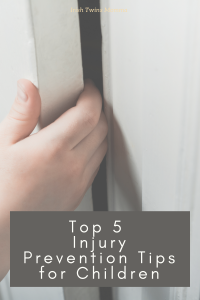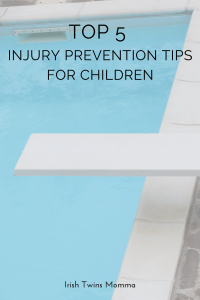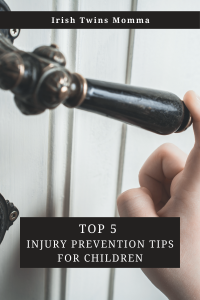This post contains affiliate links. If you click and buy, I may make a commission, at no cost to you. See my disclosure policy for more information.
With their endless curiosity, energy, and remarkable ability to find trouble, children have a high risk of injuries.
Every year, around 8000 families in America lose their children to preventable injuries. This is a small part of the staggering 1 million families globally that loses a child to preventable injuries yearly. This is obviously a big issue that we need to address. When you lose a child, your life entirely changes.
That said, with schools and daycares closed due to lockdowns, the parents are working from home and also tending to the chores. Many parents are stretched thin trying to juggle increased responsibilities.
Preventing injuries has become more challenging. Managing everything and still maintaining proper supervision on the rambunctious little ones is hectic. Unfortunately, less supervision means more injuries.
However, these top 5 injury prevention tips for children can dramatically reduce the risks associated with injuries, indoors and outdoors.
1. Embrace essential home safety measures
While our homes provide our kids with a place to play, relax and unwind with family, some areas can be dangerous. Staircases can lead to falls, bathtubs and swimming pools can cause drowning, and kitchens can cause burns.
However, we can prevent injuries from happening by adopting a few safety measures.
Drowning
To prevent drowning embrace the following safety measures;
- Avoid leaving your kids alone in places where there is water like baths, creeks, swimming pools, and streams;
- Empty water from wading pools, buckets, and bathtubs, and consistently close the bathroom door;
- Teach your kids to follow the swimming rules. For examples, at the beach, they should swim between the flags;
- Put barriers around the swimming pools and remove objects that can aid in climbing over. Remember to keep the swimming pool gates closed;
- Secure your aquariums and fishponds using the appropriate covers;
- Teach your kids to swim, water awareness, and familiarization techniques;
- Pin a resuscitation chart on the spa/ pool area and in an easily accessible place.
Falls
In America, approximately 8,000 children are treated daily due to fall related injuries. This makes falls the leading cause of non-fatal injuries. Thankfully, parents can adopt safety measures including;
- Remove all tripping hazards around the place your kids play to create a clear playing path. Things like electrical cords, rugs, toys. Pad sharp corners of tables and benches from the playing area;
- Adapt usage of safety gates around the stairs and always keep young kids strapped in swings and high chairs;
- Anchor all TVs and furniture to avoid tip-over injuries.
Burns
Burn injuries, including flames and scald burns, can result in disability, disfigurement, and permanent scarring. To prevent burns;
- Keep kids away from the kitchen, hot liquids, and food;
- Avoid holding your child when carrying a hot substance;
- Keep the bathwater at a safe temperature (37-38°C) and limit your home hot water delivery outlets to 50°C; and,
- Always keep your kitchen or bathroom door closed.
2. Insist on helmets
Riding bikes and scooters has physical, mental, and healthy benefits. That said, riding also makes your children stay active while still practicing social distancing.
So, whether it’s scooter spinning, hoverboard cruising, bike riding, skating, or other all-terrain vehicles, ensure your children use helmets. Helmets keep your children safe when on wheels.
Wearing properly fitted helmets reduces the risk of head injuries. The helmets should;
- Meet the safety standards of the American Consumers Products Safety Commission;
- Directly be placed down on your child’s forehead, with the front strap being slightly and vertically in front of your child’s ears. The back/rear strap should horizontally be behind the ears. Ensure after fitting, these straps form a V shape;
- Tighten the chinstrap to prevent the helmet from slipping backward or forward. Remember, only a finger should fit in the space between the strap and the chin.
3. Embrace smart pedestrian safety
Children love walking around, which is good for their physical and mental health. Walking helps the brain to release endorphins chemicals that regulate mood while improving overall behavioral health. That said, it’s advisable to adopt pedestrian safety. Teach your kids;
- To always stay alert when walking by keeping off devices and paying attention to their surroundings. Besides being cautious of cars, look out for runners, other walkers, and bikers. Remind older children to avoid using their gadgets unless for emergencies and to pay attention.
- To use pedestrian-marked crosswalks and sidewalks even when the traffic is sparse to remain safe; and,
- To wear bright or light clothing or reflective accessories/clothing when walking after sundown or at night, so they can easily be seen by drivers.
4. Adhere to road traffic safety
Every hour, emergency departments across America treat over 150 children for road traffic injuries. Crash-related injuries are the leading cause of injury deaths in children.
However, you can prevent and minimize these injuries by using the correct car booster seat or car seat. Always ensure your kids are buckled up according to their appropriate size and age.
- A rear-facing car seat works well for children below four years or until they reach the maximum height or weight.
- Forward-facing car seats work best for kids who have outgrown the rear-facing seat.
- The booster seat is ideal for children who have outgrown forward-facing car seats or have reached the height of 4feet9 inches (around 9-12 years).
- The seat belt works best for kids who have outgrown booster seats, or the belt fits properly. A well-fitting seat belt should lie comfortably across the child’s upper thighs and the shoulder belt across their chest.
- Always seat children under 12 in the back seat or at the middle seat and never in front.
- Avoid seating your child in front or near the airbags.
- Regardless of how short or long the trip may be, buckle up your kids.
5. Embrace playground safety
Every year over 200,000 children in America below the age of 14 get treated for playground-related injuries. These range from minor abrasions and fractures to traumatic brain injuries. These injuries can be caused by a collision or a fall from playground equipment like slides, trampolines, and hard surfaces.
Trampoline related injuries happen due to:
- Colliding or landing on each other;
- Improper landing when doing stunts or jumping;
- Jumping off or falling from the trampoline; and,
- Falling on the straps of the trampoline frame or springs.
If your child suffers from trampoline-related injuries due to negligence, you can file a personal injury lawsuit. However, you can adapt some measures to reduce trampoline/playground injuries, and they include:
- Ensuring the playground surface has appropriate materials like sand or wood chips. The surface materials should remain well-maintained and of proper depth.
- Read the playground signs and advise your children to use the right equipment according to their age.
- Looking out for unwanted things like rocks and stumps in the play area
- Ensuring your kids play with equipment that has guardrails to prevent falls
- Allowing only one kid to play on the trampoline
- Put a trampoline enclosure to prevent falls.
Conclusion
As parents, we love it when our kids exercise and play outside, but the fear of injuries may prevent us from allowing them to fully enjoy their childhood. However, knowledge of the above tips gives you the ability and power to protect them, to some extent, and hopefully avoid visiting the emergency department.
Guest Post by Rita Geofrey




Leave a Reply